By Susan Harkins, Jeff Nelson, & David Taylor
In any list of the top five invasive plant threats to Kentucky’s native plant communities, bush honeysuckle would appear in all of them. There are three species of bush honeysuckle commonly found in Kentucky: Amur (Lonicera maackii), Morrow’s (L. morrowii), and Tartarian (L. tatarica). Another two, Standish’s (L. standishii) and Fragrant (L. fragrantissima), are less common. All are members of the Caprifoliaceae (Honeysuckle) family. All of them are similar in appearance and effect. Because of the similarities and because it is the most widespread of the bush honeysuckles, the rest of this article will concentrate on Amur honeysuckle. There are slight differences in appearance between Amur honeysuckle and the other bush honeysuckles, but in general they are similar enough to easily recognize.
Description
Most of us have seen invasive Lonicera while hiking or even around town. They’re everywhere. Knowing how to identify them is the first step to removing them.
Appearance
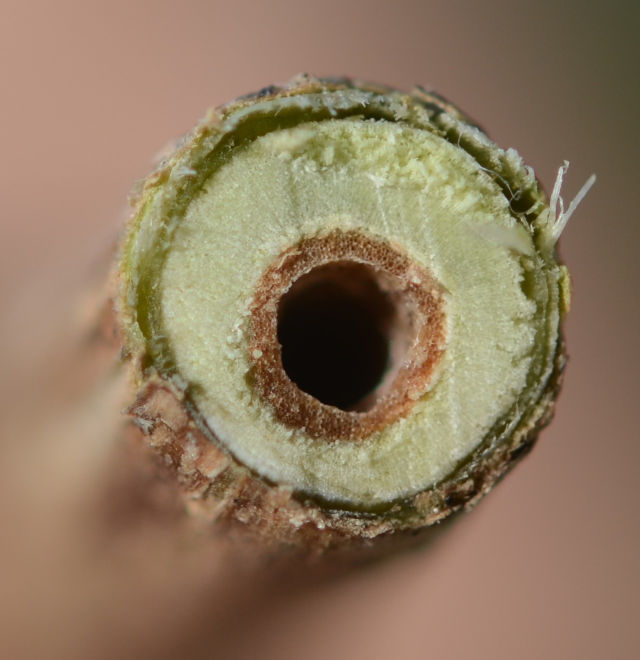
Lonicera maackii is a woody perennial shrub that, at maturity, is typically 6’-20’ tall, but occasionally taller. The shrubs are upright and deciduous. Although deciduous, in Kentucky the bush honeysuckles retain their leaves longer in the fall than native shrubs and leaf out earlier in the spring. The pith of mature stems is hollow and white or tan.
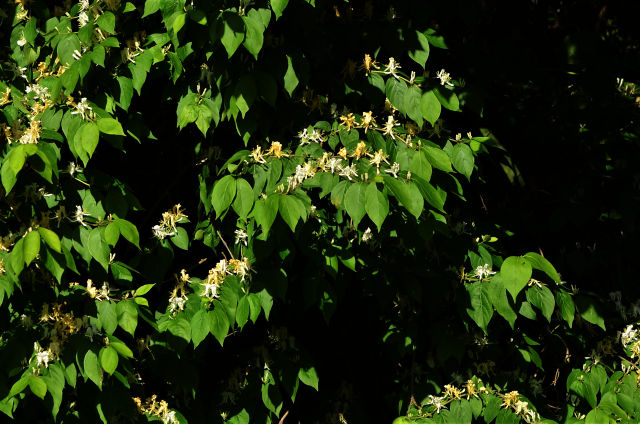
Leaves
Leaves are opposite, ovate with a tapered tip, lightly pubescent, and up to 3½ in. long.
Flowers
Flowers are paired, tubular, white to pinkish, fading to yellow, less than 1 in. long, borne from leaf axils, five petals, upper 4 fused.
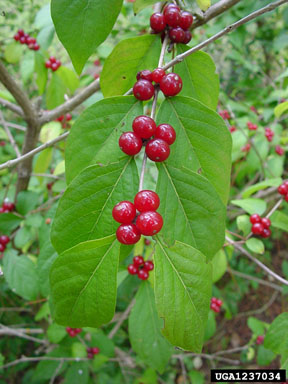
Fruit
Fruits are red to orange-red berries produced in late summer and persist through the winter. This shrub can bear fruit when it is as young as 3 to 5 years old.
Habitat
Amur honeysuckle is one of the most common and invasive bush honeysuckles found in Kentucky. It occurs in most states in the eastern U.S. except for Minnesota, Maine and Florida and has been reported to be invasive in many. It is adaptable to a range of conditions from sun to deep shade and wet to dry. It occurs in disturbed habitats including forest edges, forest interiors, floodplains, old fields, pastures, and roadsides. Disturbance increases the likelihood of invasion. Amur honeysuckle grows especially well on calcareous soils.
It spreads by fruits that are abundant and highly attractive to birds that consume them and defecate the seeds in new locations. Vegetative sprouting aids in the local spread and persistence. It does not generally root sprout.
Where Found in KY
The bush honeysuckles are found across Kentucky, in any just about any suitable habitat.
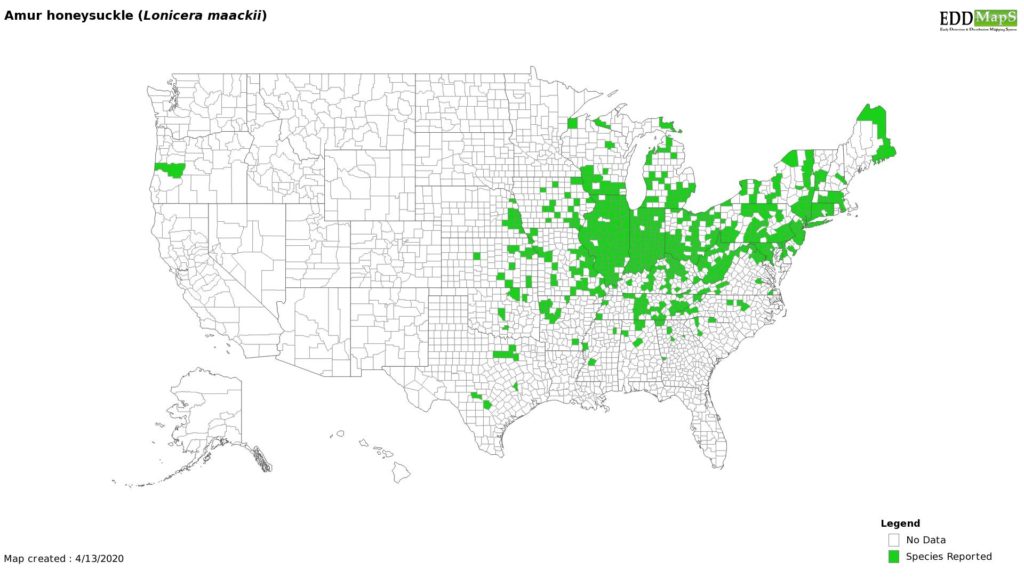
How it Got Here
NE China, Japan, Korea, and Russian Far East
Amur honeysuckle was imported as an ornamental into New York in 1898 through the New York Botanical Garden. It has been widely planted for wildlife cover and soil erosion control but long ago escaped from plantings and began reproducing on its own and spreading into natural areas. It was originally planted in the U.S. as an ornamental shrub, but it quickly escaped gardens and naturalized throughout much of the eastern U.S. to the Great Plains into a variety of sites including roadsides and railroads, woodland borders, some forests, fields, unused or disturbed lands and yard edges. Once spread into the wild, it can form dense, shrubby, understory colonies that eliminate native woody and herbaceous plants. Amur honeysuckle flowers late April to June, and the white and yellowish flowers produce red berries in the fall that may contain more than 1 million seeds on mature (25-year-old), 20-foot tall plants. The seeds are consumed and spread by some species of songbirds generally after other more nutritious native foods are gone. As with many invasive species, bush honeysuckle can grow and thrive over a wide range of habitats. In Kentucky, all shrub honeysuckles are exotic and invasive.
Ecological Impacts
Amur honeysuckle impedes reforestation of cut or disturbed areas and prevents reestablishment of native plants. It leaves out earlier than most natives and form dense thickets too shady for most native species. Additionally, researchers in the Midwest found increased nest predation of robins using Amur honeysuckle as a result of plant structure, which facilitates access to nests by predators such as snakes. While the carbohydrate-rich fruits of exotic honeysuckles provide some nutrition for birds and rodents in winter, they do not compare to the lipid-rich fruits of native species that provide greater energy to sustain migrating birds. Few insects feed on the plant, but birds and mammals spread the fruits. It may have allelopathic effects on neighboring plant species.
How to Control
There are several methods for controlling–removing–invasive bush honeysuckle. They all take tenacity and a bit of effort.
Manual/Mechanical
Young plants can be pulled by hand. Larger plants either can be pulled using a weed lever-type tool or cutting repeatedly for a few years.
Grazing
Goats are particularly fond of this this plant and will rapidly consume young plants and any they can climb into. Cutting larger plants and allowing goats to eat the sprouts can be effective, but could take several years depending on what root reserves the plants have.
Fire
Fire will kill seedlings. Larger plants may be top killed, but mostly likely will sprout from the base. The sprouts must be treated as well.
Biological Control
No biological controls are currently available for this plant. However, the honeysuckle leaf blight fungus (Insolibasidium deformans) has been found in both northern and central Kentucky. It has been observed severely injuring and killing open grown populations of Amur honeysuckle.
Herbicides
Appropriate herbicides, when applied correctly, are known to effectively control bush honeysuckle through cut stem, foliar, and bark applications. Contact your local Extension Office, or Natural Resources Conservation Service office or Kentucky Department of Fish and Wildlife private lands biologist for recommendations concerning herbicide choice, application rate and application method that best suit your conditions and needs.
Native Alternatives
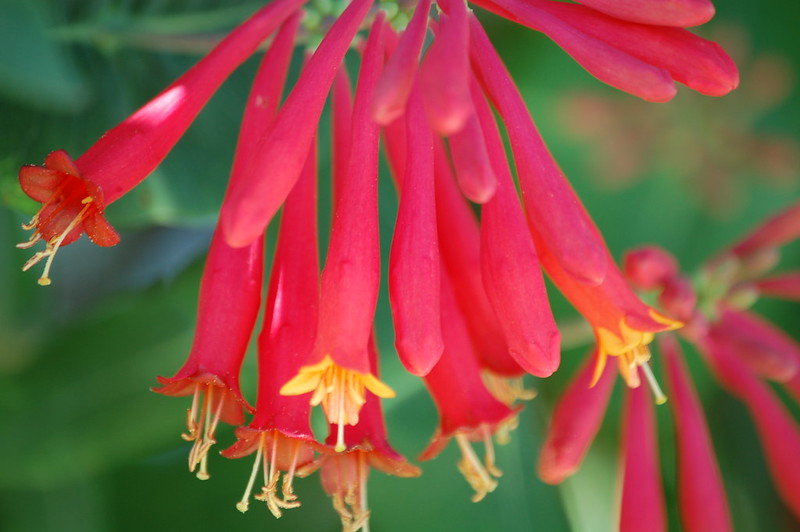
Whether you were raised in Kentucky or you’re an implant, you’ve probably enjoyed the luscious fragrance of honeysuckle as the sun begins to set. It isn’t quite jasmine; not quite gardenia; it’s unique, powerful, and intoxicating. It’s easy to understand why homeowners planted the invasive Loniceras. Where alternatives are concerned, there’s good and bad news. The good news is that we have native Lonicera. The bad news is, they are pollinated by bees and hummingbirds, so the scent is weak. In comparison, the invasive is pollinated by moths—hence the strong evening scent. What the natives lack in fragrance, they make up for in color (to attract the bees and hummingbirds).
Across North America, there are over a dozen native Lonicera species. In Kentucky, we have one to consider: Lonicera sempervirens L., trumpet or coral honeysuckle. It prefers moist soil and full sun, but tolerates shade, although, in the shade, it will produce blooms for a shorter period of time.
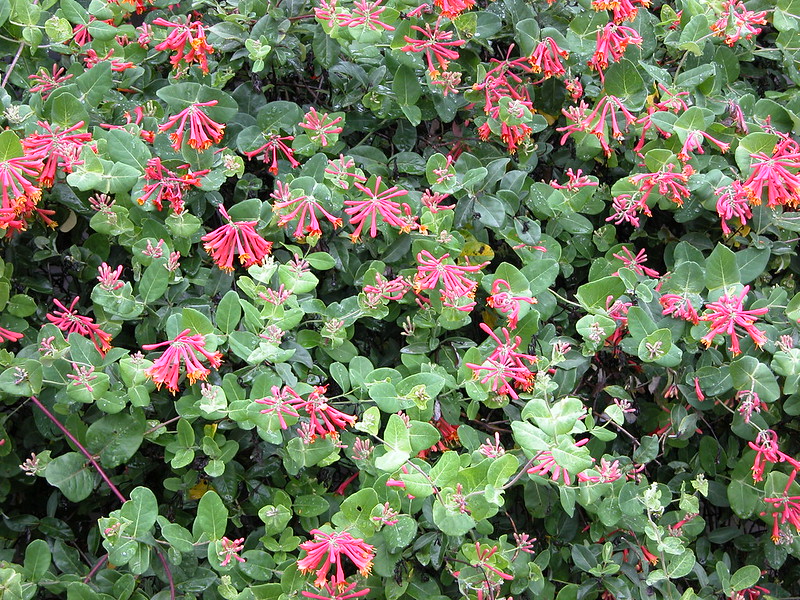
Lonicera sempervirens is one of the longest-blooming natives available to us here in Kentucky. It’s brilliant red trumpet-shaped flowers spring into life as early as late March and persist into fall, even early winter. Its leaves often persist throughout the cold, giving a bit of winter interest. The base is woody and gnarly (interesting to look at) but the vigorous upper vines are gentle and easily coiffed if necessary. You can train it to look like a bush if you prefer.
Unfortunately, Lonicera sempervirens won’t gift you with a glorious fragrance. If that’s what you’re after, consider Wisteria frutescens (L.) Poir., Kentucky wisteria. Similar to Lonicera, you’ll get the most blooms in full sun, but it will tolerate shade. It’ll grow in the same type of moist soil as well. It’s purple blooms are larger and showier, and it’ll grow a bit larger than Lonicera, but the native species isn’t as harmful to structures as the invasive Wisteria floribunda and Wisteria sinensis. Wisteria is stronger and woodier than Lonicera so it will require a stronger support, such as a strong arbor. (Resist growing it along a fence or up the side of your house because it’s difficult to remove.) It’s also more assertive than the native Lonicera, so it might require a bit more care to keep it under control.
There are several other species of Lonicera listed as native to Kentucky by the USDA plants database, but they’re rare or endangered. It’s unlikely you will find one in a reputable nursery.
For other alternatives to bush honeysuckle, check out the brochure, Kentucky’s Native Alternatives to Invasive Plants.
Photo Credits: Lonicera by common license thanks to Biodiversity Heritage Library.
Information sources:
Lonicera maackii – Invasive Plant Atlas – . Accessed April 2020.
